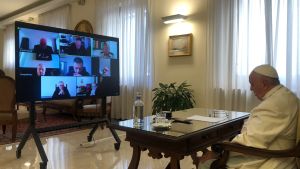The word “synod” comes from the Greek synodos, meaning “an assembly.” Synods in the Catholic Church generally feature an assembly of bishops, who come together to assist the Holy Father in addressing the needs of the Church.
Initially, many of these synods were held locally, within various regions of the world, to deal with local disciplinary issues. Synods of this type date back to the 4th century.
Pope Paul VI revived the idea of the synod and established the Synod of Bishops in 1965 with the Motu Proprio Apostolica Sollicitudo.
The current Code of Canon Law details the purpose of this smaller group of bishops who meet together to discuss various topics.
The synod of bishops is a group of bishops who have been chosen from different regions of the world and meet together at fixed times to foster closer unity between the Roman Pontiff and bishops, to assist the Roman Pontiff with their counsel in the preservation and growth of faith and morals and in the observance and strengthening of ecclesiastical discipline, and to consider questions pertaining to the activity of the Church in the world.
Furthermore, “It is for the synod of bishops to discuss the questions for consideration and express its wishes but not to resolve them or issue decrees about them unless in certain cases the Roman Pontiff has endowed it with deliberative power, in which case he ratifies the decisions of the synod.”
The bishops may meet together to discuss issues that involve the universal Church, or “considers affairs that directly pertain to a determinate region or regions.”
There were many synodal assemblies held under the reign of St. John Paul II, such as one held in 1994 on “The Consecrated Life and Its Role in the Church and in the World.” Pope Benedict XVI similarly held synods, including one on “The Word of God in the Life and Mission of the Church.”
Since John Paul II, there have also been various synods focusing on local regions of the world, such as America (1997), Europe (1999) and Africa (2009).
In each situation the group of bishops discussed particular issues and made suggestions as to how the Church could approach various problems. However, in most cases the solutions were primarily focused on new approaches, rather than binding law.
The Synod meets in different types of Assembly: in an Ordinary General Assembly, for matters concerning the good of the universal Church; in an Extraordinary General Assembly, for matters of urgent consideration; in a Special Assembly, for matters which mostly concern one or more specific geographical regions.
Pope Francis has convoked multiple synods during his pontificate, and in 2021 initiated a synod on the theme “For a Synodal Church.” This synod will include both an Ordinary General Assembly and local Diocesan synods connected to it. This synod will end in 2023, concluding a two-year synodal process.



